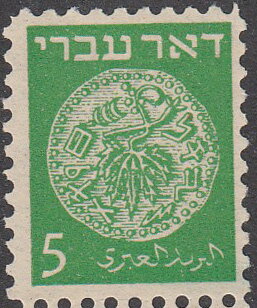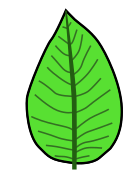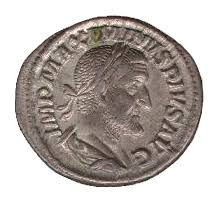Stamp: Coins Doar Ivri - 5m (Israel 1948)
Coins Doar Ivri - 5m (Israel 1948)
16 May (Israel ) within release Coins Doar Ivri goes into circulation Stamp Coins Doar Ivri - 5m face value 5 Israeli mil
| Stamp Coins Doar Ivri - 5m in catalogues | |
|---|---|
| Stanley Gibbons: | Sg: IL 2b |
Stamp is vertical format.
Also in the issue Coins Doar Ivri:
- Stamp - Coins Doar Ivri face value 3;
- Stamp - Coins Doar Ivri face value 5;
- Stamp - Coins Doar Ivri face value 10;
- Stamp - Coins Doar Ivri face value 15;
- Stamp - Coins Doar Ivri face value 20;
- Stamp - Coins Doar Ivri face value 50;
- Stamp - Coins Doar Ivri face value 250;
- Stamp - Coins Doar Ivri face value 500;
- Stamp - Coins Doar Ivri face value 1000;
- Stamp with Collectible Margin - Coins Doar Ivri face value 10;
- Stamp with Collectible Margin - Coins Doar Ivri face value 15;
- Stamp with Collectible Margin - Coins Doar Ivri face value 15;
- Stamp - Coins Doar Ivri face value 15;
- Stamp - Coins Doar Ivri face value 15;
- Stamp with Attached Label - Coins Doar Ivri face value 15;
- Stamp with Collectible Margin - Coins Doar Ivri face value 20;
- Stamp with Collectible Margin - Coins Doar Ivri face value 20;
- Stamp - Coins Doar Ivri face value 20;
- Stamp with Collectible Margin - Coins Doar Ivri face value 50;
- Stamp with Collectible Margin - Coins Doar Ivri face value 50;
- Stamp with Collectible Margin - Coins Doar Ivri face value 50;
- Stamp with Collectible Margin - Coins Doar Ivri face value 50;
- Stamp - Coins Doar Ivri face value 50;
- Stamp - Coins Doar Ivri face value 50;
- Stamp - Coins Doar Ivri face value 50;
- Stamp with Collectible Margin - Coins Doar Ivri face value 250;
- Stamp with Collectible Margin - Coins Doar Ivri face value 250;
- Stamp with Collectible Margin - Coins Doar Ivri face value 250;
- Stamp - Coins Doar Ivri face value 250;
- Stamp - Coins Doar Ivri face value 250;
- Stamp with Collectible Margin - Coins Doar Ivri face value 500;
- Stamp with Collectible Margin - Coins Doar Ivri face value 500;
- Stamp with Collectible Margin - Coins Doar Ivri face value 500;
- Stamp - Coins Doar Ivri face value 500;
- Stamp - Coins Doar Ivri face value 500;
- Stamp with Collectible Margin - Coins Doar Ivri face value 1,000;
- Stamp with Collectible Margin - Coins Doar Ivri face value 1,000;
- Stamp with Collectible Margin - Coins Doar Ivri face value 1,000;
- Stamp - Coins Doar Ivri face value 1,000;
- Stamp - Coins Doar Ivri face value 1,000;
- Stamp with Collectible Margin - Coins Doar Ivri - 10m face value 10;
- Stamp with Collectible Margin - Coins Doar Ivri - 10m face value 10;
- Stamp - Coins Doar Ivri - 10m face value 10;
- Stamp with Collectible Margin - Coins Doar Ivri - 3m face value 3;
- Stamp - Coins Doar Ivri - 3m face value 3;
- Stamp - Coins Doar Ivri - 3m face value 3;
- Stamp with Collectible Margin - Coins Doar Ivri - 3m face value 3;
- Stamp with Collectible Margin - Coins Doar Ivri - 3m face value 3;
- Stamp with Collectible Margin - Coins Doar Ivri - 5m face value 5;
- Stamp - Coins Doar Ivri - 5m face value 5;
- Stamp with Collectible Margin - Coins Doar Ivri - 5m face value 5;
Stamp Coins Doar Ivri - 5m it reflects the thematic directions:
A coin is a small object, usually round and flat, used primarily as a medium of exchange or legal tender. They are standardized in weight, and produced in large quantities at a mint in order to facilitate trade. They are most often issued by a government. Coins often have images, numerals, or text on them. The faces of coins or medals are sometimes called the obverse and the reverse, referring to the front and back sides, respectively. The obverse of a coin is commonly called heads, because it often depicts the head of a prominent person, and the reverse is known as tails.
A leaf (pl.: leaves) is a principal appendage of the stem of a vascular plant usually borne laterally aboveground and specialized for photosynthesis. Leaves are collectively called foliage, as in "autumn foliage", while the leaves, stem, flower, and fruit collectively form the shoot system. In most leaves, the primary photosynthetic tissue is the palisade mesophyll and is located on the upper side of the blade or lamina of the leaf but in some species, including the mature foliage of Eucalyptus,palisade mesophyll is present on both sides and the leaves are said to be isobilateral. Most leaves are flattened and have distinct upper (adaxial) and lower (abaxial) surfaces that differ in color, hairiness, the number of stomata (pores that intake and output gases), the amount and structure of epicuticular wax and other features. Leaves are mostly green in color due to the presence of a compound called chlorophyll which is essential for photosynthesis as it absorbs light energy from the sun. A leaf with lighter-colored or white patches or edges is called a variegated leaf.
Numismatics is the study or collection of currency, including coins, tokens, paper money, medals and related objects.
Flora is the plant life occurring in a particular region or time, generally the naturally occurring or indigenous—native plant life. The corresponding term for animal life is fauna. Flora, fauna and other forms of life such as fungi are collectively referred to as biota. Sometimes bacteria and fungi are also referred to as flora, as in the terms gut flora or skin flora.




